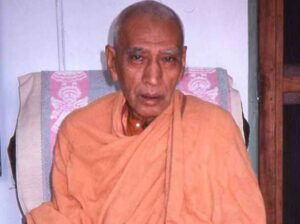
Birth and Early Life
Swami Kailashanandaji Maharaj came from a pious and cultured family of Dhaka, Bangladesh. He was born on 8 December 1893. Shaileshachandra Bandyopadhya, as he was named by his parents, was spiritually inclined since boyhood. After a brilliant academic career, he joined the University of Dhaka as a professor of history. He came in contact with many of the monastic disciples of Sri Ramakrishna. He was especially loved by Swami Shivanandaji Maharaj, his guru, who took him in hand and moulded his life.
Beginning of Monastic Life
Burning with the twin ideals of “renunciation and service” set by Swami Vivekananda, he gave up a promising professional career and joined the Ramakrishna Order in 1929 at Belur Math. Less than a year after his joining the order, Swami Shivanandaji, who was highly impressed by the purity and sincerity of his disciple, gave him sannyasa diksha in October 1930, making an exception to the normal rule that required several years of novitiate in the order before being considered for sannyasa ordination. Shaileshachandra now came to be known as Swami Kailashananda.
As a young monk, he served his guru as his sevak and private secretary. Swami Shivanandaji permeated his whole personality, and Swami Kailashanandaji was ever full of the reminiscences of the blessed days he spent with his guru. After the mahasamadhi of Swami Shivanandaji in February 1934, he served as a private secretary to Swami Akhandanandaji Maharaj for a year or so.
Swami Kailashanandaji was appointed head of the Mission’s branch in Delhi in 1936. His selfless and untiring service drew the attention of high authorities in the capital. The T.B. clinic of the branch came to be well organised under his leadership.
In 1944, he went to Chennai as the head of Sri Ramakrishna Math, Mylapore. He served in Chennai for 26 long years, thus spending there the major part of his active life. During his tenure, the activities of Chennai Math spread extensively. The charitable dispensary got housed in a spacious building with the necessary equipment. A spacious library hall and an auditorium were added on an adjacent plot of land that was acquired and added to the Math premises. The publication department brought out many important books of the Ramakrishna- Vivekananda literature, notably the Gospel of Sri Ramakrishna and Sri Ramakrishna – The Great Master. A Telugu monthly Sri Ramakrishna Prabha was started. A noticeable feature of Swami Kailashanandaji’s tenure as the head was the religious fervour with which vast crowds attended the elaborate festivals in the Math. Durga Puja was performed in the image consecutively for three years, and this brought considerable popularity and prosperity to the Math.
Swami Kailashanandaji’s life of exemplary piety and renunciation made a deep impact on the monastics of the Math and the devotees visiting it. Under his spiritual care, many aspirants joined the Math and became monks.
While in Chennai, he was appointed a trustee of the Ramakrishna Math and Governing Body Member of the Ramakrishna Mission in 1961.
He returned to Belur Math in 1971 to become the Treasurer of the Math and the Mission. Four years later, in March 1975, he was elected as a Vice-President of the twin organizations. His elevation to this high office was but a fitting tribute to Swami Kailashanandaji’s self-discipline, austerity, devotion to Sri Ramakrishna, unqualified faith in his guru and, above all, his unflinching loyalty to the Sangha. Swami Kailashanandaji was a stern disciplinarian, and at the same time full of compassion, to those under his charge. He adhered very strictly to the ideals of sannyasa. He had a fine sense of humour and was a good raconteur. He was a veritable mine of information as regards the history of the Math and the Mission. He could remember so many details about even small incidents that had taken place long ago.
Mahasamadhi
Sometime around 1976 Swami Kailashanandaji developed an ulcer in his intestine and suffered from internal bleeding. He was admitted to Seva Pratishthan hospital in Kolkata where he underwent surgery. His health improved considerably following this. However, in the middle of 1978, there was excessive internal bleeding. Doctors diagnosed his case as intestinal cancer. He was once again admitted to Seva Pratishthan hospital. Though in the beginning he responded well to the treatment, his condition deteriorated fast. Eventually, the end came on 16 December 1978.
Related Articles: